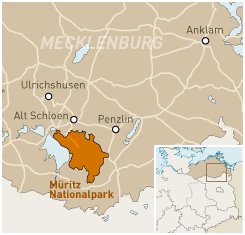Müritz National Park
Until 1989, the GDR was lacking the category "national park" completely, as there was no significant
political intend in that field. On the one hand, the term "national" was connoted rather negatively, on
the other hand, as much land as possible had to be devoted to agriculture in order to guarantee the productivity
of the national economy. In contrast, as tourism was promising a high profit, one prioritised the planning of
touring accommodations in smaller nature reserves chosen beforehand. Only in 1990, after the end of the Cold War,
these areas were incorporated into the precise planning of the national parks. Fifteen formerly isolated nature parks
then merged to become the Müritz National Park.
Within the national park, more than a hundred lakes larger than one hectare can be found as the ground-water table is considerably high. The lake of Müritz itself is the centre of the Mecklenburg lake district. The ground is mainly composed of loamy and sandy soils which are nutrient-poor so that an agricultural usage is almost impossible. Nevertheless, this had been attempted in the GDR. The ground was fertilised and worked with machines. Due to military use and gravel excavation the surface on which the vegetation usually grows had been destroyed. Open sand fields were created. In the future, these shall be abandoned in order for nature to develop freely. Elsewhere, pastures that have been used for centuries will be maintained by extensive farming, in this particular case by the grazing of sheep.
Within the national park, more than a hundred lakes larger than one hectare can be found as the ground-water table is considerably high. The lake of Müritz itself is the centre of the Mecklenburg lake district. The ground is mainly composed of loamy and sandy soils which are nutrient-poor so that an agricultural usage is almost impossible. Nevertheless, this had been attempted in the GDR. The ground was fertilised and worked with machines. Due to military use and gravel excavation the surface on which the vegetation usually grows had been destroyed. Open sand fields were created. In the future, these shall be abandoned in order for nature to develop freely. Elsewhere, pastures that have been used for centuries will be maintained by extensive farming, in this particular case by the grazing of sheep.
Müritz National Park
Müritz National Park Preserving nature - The national park idea Bog biotopes The "Zartwitz Cabin" The Pomeranian coarsewool sheep
